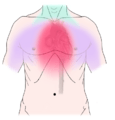Angina pectoris facts for kids
Angina pectoris (angina of the heart) is a type of chest pain or discomfort that happens when your heart muscle doesn't get enough oxygen-rich blood. It's often described as a squeezing, pressure, heaviness, tightness, burning, or choking feeling in the chest. It can also sometimes be felt in other places like the arms (often the left arm), shoulders, neck, jaw, or back. Angina is usually a sign of an underlying heart problem, most commonly coronary artery disease.
Imagine your heart is a super-strong pump that works all the time to send blood around your body. Just like any muscle, your heart muscle needs a steady supply of oxygen and nutrients to do its job. This supply comes from special blood vessels called coronary arteries that wrap around the heart. Angina happens when these coronary arteries become narrowed or blocked, usually by something called plaque. Plaque is a sticky substance made of fat, cholesterol, and other things that can build up inside the arteries over time. This buildup is called atherosclerosis.
When the arteries are narrowed, less blood can flow through them, meaning the heart muscle doesn't get as much oxygen as it needs, especially when it's working harder, like during exercise or when you're feeling stressed. This lack of oxygen to the heart muscle is called ischemia. Think of it like trying to water a garden with a hose that's partly kinked. You can still get some water through, but not as much, and the plants might not get enough, especially if you need a lot of water quickly. Similarly, when your heart needs more oxygen (like when you're running), but the narrowed arteries can't deliver it fast enough, you might feel the discomfort of angina.
The word "angina" comes from old words meaning "to strangle" and "chest," which helps describe that tight or squeezing feeling some people get. It's important to know that the feeling of angina can be different for different people. Some might feel a lot of pain, while others might just feel discomfort or pressure. Also, how severe the angina feels doesn't always tell you exactly how much oxygen your heart is missing or how serious the underlying problem is. Sometimes, people can have a serious heart issue with only mild or no angina symptoms. If someone experiences new or worsening chest pain, especially if it happens at rest or lasts a long time, it's considered a medical emergency and needs to be checked by a doctor right away. This could be a sign of something more serious.
What Causes Angina?
The main reason people get angina is because of coronary artery disease, where the coronary arteries get narrowed or blocked by plaque. However, other things can also sometimes cause angina or similar chest discomfort:
- Abnormal Heart Rhythms:If the heart beats too fast or too slow, it might not pump blood effectively, affecting oxygen supply.
- Heart Failure: When the heart muscle is weakened and can't pump blood as well as it should. *Anemia: This is when you don't have enough red blood cells, which carry oxygen in your blood. If there aren't enough red blood cells, your heart muscle might not get enough oxygen even if the arteries are open.
- Spasms in the arteries:Sometimes, the coronary arteries can suddenly tighten up or spasm, temporarily reducing blood flow. This can happen even if there isn't much plaque buildup. Certain things can increase a person's chance of developing the heart problems that lead to angina. These are called risk factors. They include smoking, diabetes, high cholesterol, high blood pressure, not being very active, family history.
Sometimes, certain situations can trigger an angina attack in someone who has narrowed arteries. These can include:
- Physical Activity: Exercising or doing something strenuous makes your heart work harder and need more oxygen.
- Emotional Stress: Feeling stressed or upset can affect your heart.
- Cold Weather: Cold temperatures can sometimes make blood vessels narrow.
- Heavy Meals: Digesting a large meal can increase the heart's workload.
How is it treated?
The main goals of treating angina are to help people feel better by reducing their symptoms, to stop the heart problem from getting worse, and to lower the chance of future serious events like a heart attack. Treatment often involves a combination of lifestyle changes, medicine, and sometimes medical procedures.
Who gets angina?
Angina is a common condition, especially as people get older. As of 2010, it was estimated to affect about 112 million people worldwide. It's slightly more common in men than in women overall, but angina is often the first symptom of coronary artery disease that women experience. In the United States, millions of people experience angina, with many new cases happening each year. The chance of having angina goes up with age, and the average age when people first start having symptoms is around 62 years old.
Images for kids
See also
 In Spanish: Angina de pecho para niños
In Spanish: Angina de pecho para niños


